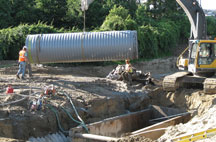
Sanitary Sewer Applications
ASTM International Committee F17 on Plastic Piping Systems has just completed the development of two new standards for polypropylene sanitary sewer pipe. These new standards are the first to address both dual wall and triple wall profile designs.
"Polypropylene has unique material characteristics, which make it ideal for sanitary sewer pipe applications," says John Kurdziel, director, technical services and market development, Advanced Drainage Systems Inc., and an F17 member. "It has excellent resistance to impact, the chemicals in sanitary sewer effluents and stress-cracking. In addition, the engineered profile configurations of these new pipes provide high pipe stiffness strengths and beam strength while utilizing less material than a standard solid wall product."
The first of the two new standards, F2736, Specification for 6 to 30 in. (152 to 762 mm) Polypropylene (PP) Corrugated Single Wall Pipe and Double Wall Pipe, is under the jurisdiction of Subcommittee F17.26 on Olefin Based Pipe. F2764, Specification for 30 to 60 in. [750 to 1,500 mm] Polypropylene (PP) Triple Wall Pipe and Fittings for Non-Pressure Sanitary Sewer Applications, is under the jurisdiction of Subcommittee F17.62 on Sewer.
Taken together, the new standards provide specifiers the opportunity to design entire systems with polypropylene pipe for the first time. Because the standards cover pipe from as small as 6 in. (152 mm) to as large as 60 in. (1,500 mm), they effectively cover the majority of pipe sizes utilized for sanitary sewer connections and trunk lines.
According to Kurdziel, the approval of both F2736 and F2764 provides manufacturers with greater flexibility in supplying a range of products for sanitary sewer applications, resulting in lower overall costs to municipalities while still obtaining equitable products.
A new 1,000-hour hydrostatic test that ensures the long-term integrity of the joint performance has been incorporated into F2764. "This new requirement provides assurance to the user that the pipe's watertight integrity, which is critical for sanitary sewers, will be maintained over the life of the project," says Kurdziel.
Kurdziel says that the hydrostatic test as it appears in F2764 has been deemed so useful that it is currently being developed as its own separate standard, WK28716, Test Method for Long-Term Evaluation of Thermoplastic Pipe Joints.
Consulting and municipal engineers, as well as contractors who provide technical and logistical support for specifying and installing sanitary sewer systems, will be the primary users of F2736 and F2764. Kurdziel notes that anyone interested in evaluating the protocol proposed for long-term hydrostatic/vacuum joint testing of thermoplastic pipe is welcome to participate in the activities of F17.40. The participation of testing laboratories and users would be particularly beneficial in the ongoing development of WK28716.
To purchase ASTM standards, visit www.astm.org and search by the standard designation number, or contact ASTM Customer Relations (phone: 610-832-9585). CONTACT Technical Information: John Kurdziel, Advanced Drainage Systems Inc. • Hilliard, Ohio • Phone: 614-658-0211 • E-mail: john.kurdziel@ads-pipe.com O ASTM Staff: Robert Morgan • Phone: 610-832-9732 • E-mail: rmorgan@astm.org O Upcoming Meeting: Nov. 15-18 • November Committee Week • San Antonio, Texas
 SN Home
SN Home Archive
Archive Advertisers
Advertisers Masthead
Masthead RateCard
RateCard Subscribe
Subscribe Email Editor
Email Editor